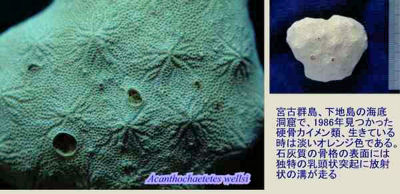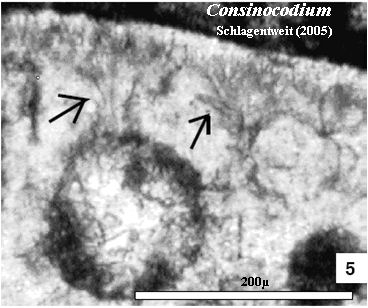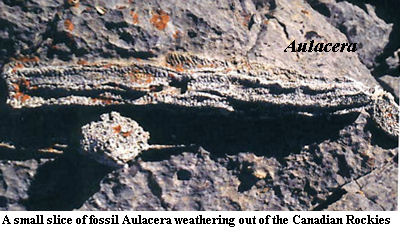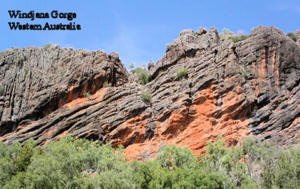
| Palaeos: |  |
Stromatoporoidea |
| Porifera | Stromatoporoidea - 1 |
| Page Back | Unit Back | Metazoa | Metazoa Dendrogram | Metazoa References | Pieces | Taxon Index |
| Page Next | Unit Next | Unit Home | Unit Dendrogram | Unit References | Glossary | Time |
PORIFERA |--Archaeocyatha `--+--Stromatoporoidea `--+--Calcarea `--+--Hexactinellida `--+--Demospongiae | |--Tetractinomorpha | `--Ceractinomorpha `--+--Homoscleromorpha `--EUMETAZOA |
Introduction Anatomy Outer surface: mamelons and astrorhizae. Inner Matrix: pillars and latilaminae Spicules: Mesozoic forms only Water Canal System: poorly known, stromatactis-like. Ecology Distribution: Middle Paleozoic, Mesozoic, and Recent. Phylogeny Conclusion |
 Stromatoporoids are best known for being the main reef builders of the
Middle
Paleozoic. Everyone seems happy with that statement, at least up to a point.
Also, almost everyone agrees that they are sponges -- which is almost
meaningless since sponges are said to be merely a "grade of organization."
The
stromatoporoids have proven almost impossible to characterize beyond that point.
The current, tentative, take on the group is that it is another "grade of
organization," not a
phylogenetic entity. It is often said that Stromatoporoidea
is largely composed of
stem sponges,
or stem demosponges, massively
calcified, with closely-spaced
laminar or
tabular
layers and roughly vertical columns.
Stromatoporoids are best known for being the main reef builders of the
Middle
Paleozoic. Everyone seems happy with that statement, at least up to a point.
Also, almost everyone agrees that they are sponges -- which is almost
meaningless since sponges are said to be merely a "grade of organization."
The
stromatoporoids have proven almost impossible to characterize beyond that point.
The current, tentative, take on the group is that it is another "grade of
organization," not a
phylogenetic entity. It is often said that Stromatoporoidea
is largely composed of
stem sponges,
or stem demosponges, massively
calcified, with closely-spaced
laminar or
tabular
layers and roughly vertical columns.
After that, things get really peculiar. For example, stromatoporoids are first
found in the Tommotian (Wood,
1998), or perhaps the
Botomian (Benton &
Harper, 1997) ... or should that be
Middle Ordovician (Webby,
2004)? Stromatoporoids flourished until the
end of the Devonian, when
they became extinct (Webby, 2004) -- except that they were also a major reef
component in the Late Jurassic
(Benton & Harper, 1997), and may not be extinct, even today (Rowland,
2001). Typically, we would now launch into a Philippic on the
inevitability of such confusion when workers do not zealously guard against
chaos by establishing careful
phylogenetic definitions. However, we have already written too much on
this topic and "as to the importance of a general zeal
in the discharge of duty, believing you are
 convinced and satisfied, I say no
more" [9]. The
problem is that, in this specific case, it is nearly impossible to construct a
testable phylogenetic definition. So "zeal in the discharge of duty" is going to
do us about as much good as it did Demosthenes and his Athenians. However,
also like Demosthenes, we refuse to allow piddling details to get in the way of
exercising our traditional right to run off at the mouth on subjects we know
nothing about.
convinced and satisfied, I say no
more" [9]. The
problem is that, in this specific case, it is nearly impossible to construct a
testable phylogenetic definition. So "zeal in the discharge of duty" is going to
do us about as much good as it did Demosthenes and his Athenians. However,
also like Demosthenes, we refuse to allow piddling details to get in the way of
exercising our traditional right to run off at the mouth on subjects we know
nothing about.
On the left is the usual sketch of a stromatoporoid. In fact stromatoporoid morphology is quite variable. They are best known, and most typically found as massive "domical" structures, but other types exist: conical, mushroom-shaped, columnar, branching, or even thin and reed-like. Benton & Harper (1997) Their skeleton (coenosteum) was calcite (or aragonite). Since they were both large and mineralized, they are frequently preserved as fossils. Stromatoporoids frequently formed reefs with bacterial stromatolites, which probably accounts for their name. Indeed, misidentifications of stromatoporoids for calcified bacterial mats, and presumably vice-versa, are still being corrected. Schlagenweit (2005); c.f. Igo et al. (1988).
 Outer
surface:
mamelons and
astrorhizae. Many paleontologists, even those who routinely work with stromatoporoids,
seem to avoid trying to make sense of their anatomy. Most of these workers seem to believe
that the living tissue of the sponge was restricted to the outer surface and one
or a few levels down into the gallery. Benton & Harper (1997). Perhaps
living tissues penetrated more deeply around the main channels of the water canal system.
In any case, the outer
surface is often organized around rounded projections called mamelons.
A network of canals, the astrorhizae, radiate outward from the low peaks
of the mamelons. Unfortunately, the details of the water canal system are
rarely preserved, so it is hard to sort things out functionally. If
stromatoporoids followed the usual pattern of sponge biology (and
sponge physics), we might
suppose
that the astrorhizae were the incurrent openings, while the central region of
the mamelons held the
excurrent openings. However, the consensus view is that it was the other
way around. Benton & Harper (1997);
Webby (2004). Further, it is not clear that the mamelons had any
particular significance since "[i]n many Recent 'sclerosponges' mamelon
structures may be present or not within the same species (Hartman 1984)."
Reitner & Engeser (1987).
Outer
surface:
mamelons and
astrorhizae. Many paleontologists, even those who routinely work with stromatoporoids,
seem to avoid trying to make sense of their anatomy. Most of these workers seem to believe
that the living tissue of the sponge was restricted to the outer surface and one
or a few levels down into the gallery. Benton & Harper (1997). Perhaps
living tissues penetrated more deeply around the main channels of the water canal system.
In any case, the outer
surface is often organized around rounded projections called mamelons.
A network of canals, the astrorhizae, radiate outward from the low peaks
of the mamelons. Unfortunately, the details of the water canal system are
rarely preserved, so it is hard to sort things out functionally. If
stromatoporoids followed the usual pattern of sponge biology (and
sponge physics), we might
suppose
that the astrorhizae were the incurrent openings, while the central region of
the mamelons held the
excurrent openings. However, the consensus view is that it was the other
way around. Benton & Harper (1997);
Webby (2004). Further, it is not clear that the mamelons had any
particular significance since "[i]n many Recent 'sclerosponges' mamelon
structures may be present or not within the same species (Hartman 1984)."
Reitner & Engeser (1987).
 Inner
Matrix: pillars and latilaminae. Webby
(2004) aptly describes the inner mesh of the coenosteum as a "monotonous"
gallery of
vertical and horizontal elements. The vertical elements are inevitably
known as pillars. In some cases, they may actually resemble pillars, as in
the early Labechiida. Id. However, they may also form short, undulating
walls, a bit like the septa of some
Irregulares.
Galloway &
St. Jean (1954). Septum-like pillars also form the outlines of the
astrorhizae.
Inner
Matrix: pillars and latilaminae. Webby
(2004) aptly describes the inner mesh of the coenosteum as a "monotonous"
gallery of
vertical and horizontal elements. The vertical elements are inevitably
known as pillars. In some cases, they may actually resemble pillars, as in
the early Labechiida. Id. However, they may also form short, undulating
walls, a bit like the septa of some
Irregulares.
Galloway &
St. Jean (1954). Septum-like pillars also form the outlines of the
astrorhizae.
The pillars are not necessarily continuous through the entire gallery. They frequently terminate at one of the latilaminae. Id. The latilaminae have been characterized as pauses in growth, like annual tree rings. If so, this would imply a rather unsponge-like growth pattern. Sponges normally grow very slowly and are said to have lifespans measured in centuries, or even millenia (although no one we know has quite enough free time to keep a sponge under close observation for even a decade or two). However, it is also believed that Paleozoic sponge reefs had growth rates comparable to modern corals. Wood (1998).
Spicules: Mesozoic forms only. Paleozoic stromatoporoids apparently did not produce spicules. However,
silica spicules have been observed in stromatoporoids from the
Jurassic.
In fact, the presence of spicules in Mesozoic stromatoporoids is one reason that
these forms are thought to be unrelated to the Paleozoic groups.
 Others
argue that that the entire skeleton may have be siliceous, but
diagenetically
transformed into
calcite. Benton & Harper (1997). Neither argument
is completely satisfactory. As the image shows, these spicules (indicated
by arrows) are difficult to distinguish from ordinary pillars.
Schlagintweit
(2005). Consequently, any conclusions from this data would be ...
spiculative.
Others
argue that that the entire skeleton may have be siliceous, but
diagenetically
transformed into
calcite. Benton & Harper (1997). Neither argument
is completely satisfactory. As the image shows, these spicules (indicated
by arrows) are difficult to distinguish from ordinary pillars.
Schlagintweit
(2005). Consequently, any conclusions from this data would be ...
spiculative.
Water Canal System: poorly known, stromatactis-like. Schlagintweit's description of the Mesozoic Consinocodium shows that it is clearly more like a modern demosponge than a Paleozoic stromatoporoid. Note the large round cavities, possibly containing choanocytes or captive bacteria -- both common in demosponges. On the other hand, the extant Acanthochaetes, at the top of this page, is indistinguishable from a typical Paleozoic stromatoporoid in external view.
Other information on the inner workings of the water canal system is hard to come by. In doing our research, we saw a few brief descriptions and images, which looked suspiciously like stromatactis. Stromatactis is an "enigmatic" (Wood, 1998) material which looks like short, often interconnected, worm burrowings. It is usually assumed to produced by bacteria. Alternatively, stromatactis may be entirely abiotic. It is a common feature of Carboniferous marine cements, but has been reported from any number of other places, including Neoproterozoic methane seeps (Jiang et al., 2003).
From this brief description, you will have gathered -- correctly -- that we weren't able to find much anatomical information on stromatoporoids, and that we believed only about half of what we found. Stromatoporoid workers are a microscopic branch of a miniscule paleosponge community, and most of the serious effort has gone into the ecology of Paleozoic reefs. Unlike anatomy and phylogeny, we can only scratch the surface of this ecological material. Those scratches are as follows.
 Distribution:
Middle Paleozoic, Mesozoic, and Recent.
The archaeocyaths died off at the end of Cambrian Epoch 2.
After that there were no metazoan reef builders, and few reefs of any kind, until
the Darriwilian Age of the
Middle Ordovician.
The first stromatoporoid "mud mounds" appear at this time. These
relatively small domical stromatoporoids usually occurred in warm, shallow,
areas on carbonate platforms, shelves, and around islands, in water conditions
of moderate energy and relatively little sediment.
Webby (2004).
At about the same time, a second ecotype developed, which had a more columnar
form (e.g., Aulacera). These were able to grow from soft, muddy
substrates at greater depth. Id. This was a singular
advantage, since there was a great deal of that sort of substrate lying fallow
at the time.
Distribution:
Middle Paleozoic, Mesozoic, and Recent.
The archaeocyaths died off at the end of Cambrian Epoch 2.
After that there were no metazoan reef builders, and few reefs of any kind, until
the Darriwilian Age of the
Middle Ordovician.
The first stromatoporoid "mud mounds" appear at this time. These
relatively small domical stromatoporoids usually occurred in warm, shallow,
areas on carbonate platforms, shelves, and around islands, in water conditions
of moderate energy and relatively little sediment.
Webby (2004).
At about the same time, a second ecotype developed, which had a more columnar
form (e.g., Aulacera). These were able to grow from soft, muddy
substrates at greater depth. Id. This was a singular
advantage, since there was a great deal of that sort of substrate lying fallow
at the time.
In the course of the Ordovician, these two types increased in size and abundance. By the Hirnantian Period, columnar forms almost 2 m tall formed calcareous "forests" in some regions. However, they never reached a worldwide distribution, as Ordovician stromatoporoids are only found within 30° latitude of the paleoequator.
 As
you might expect, given this distribution, the stromatoporoids suffered badly in
the end-Ordovician cold snap. However, they returned to form the gigantic
Middle and
Late Devonian stromatoporoid
reefs, some hundreds of meters in height, known in Australia, Morocco, Sweden,
and other locations. Whether or not they became extinct at the end of the
Devonian is not clear, but no stromatoporoid-like sponges are known from that point until the
Triassic.
As
you might expect, given this distribution, the stromatoporoids suffered badly in
the end-Ordovician cold snap. However, they returned to form the gigantic
Middle and
Late Devonian stromatoporoid
reefs, some hundreds of meters in height, known in Australia, Morocco, Sweden,
and other locations. Whether or not they became extinct at the end of the
Devonian is not clear, but no stromatoporoid-like sponges are known from that point until the
Triassic.
Stromatoporoids never again dominated the landscape, but they formed an important part of various Mesozoic reef communities, particularly in the Late Jurassic. These Jurassic forms appear to have been a very different ecotype from their Paleozoic relatives (or analogues, as the case may be). The Mesozoic stromatoporoids tended to inhabit unstable, high energy, high-sediment regions, often in rather shallow, turbulent waters. Leinfelder et al. (1996); Benton & Harper (1997). They disappear again at the end of the Cretaceous until 30 years ago, when living species began to turn up in deep water at the height of the Cousteau Era in the 1970's.
| Page Back | Page Top | Unit Home | Page Next |